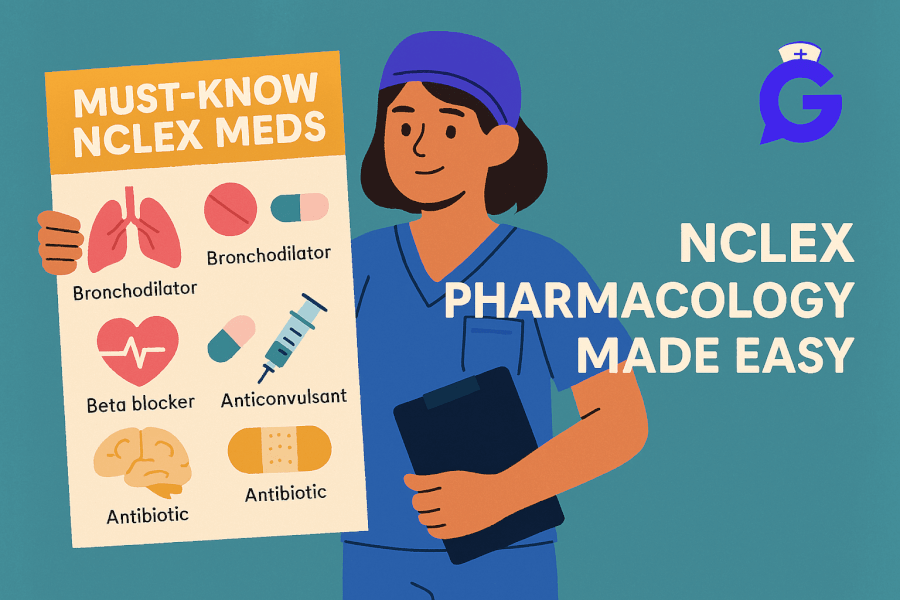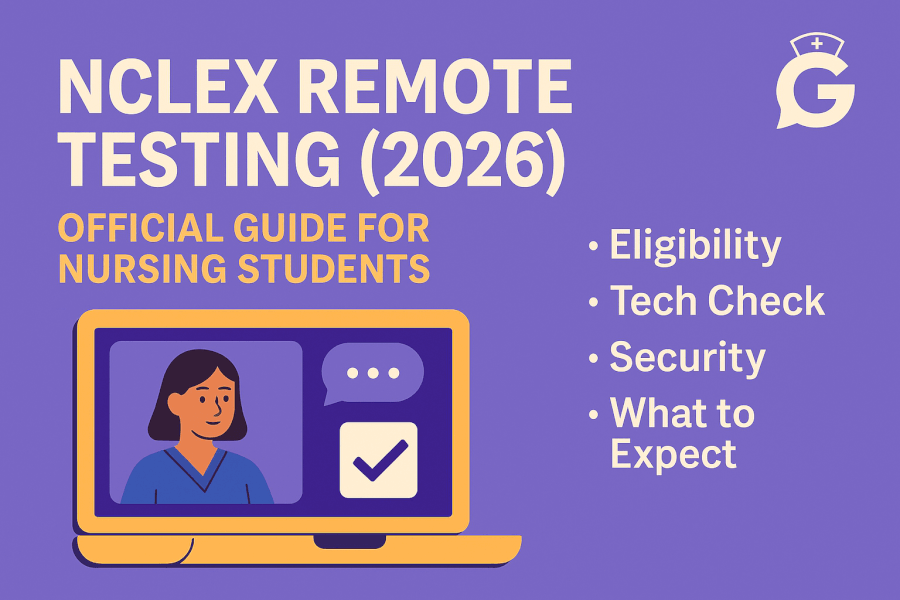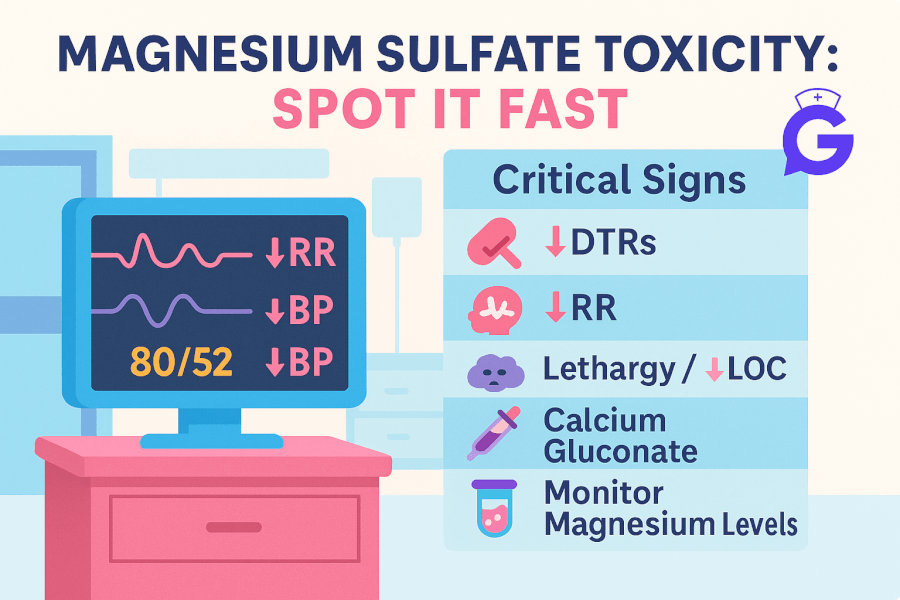(Updated April 2025)
The NCLEX exam is a crucial step in becoming a licensed nurse. To succeed, you’ll need more than just content knowledge—you must understand and apply key nursing terms in clinical scenarios. In this guide, we’ll cover 25 essential NCLEX vocabulary terms every nursing student should master, complete with real-world examples, context, and a short quiz to test your retention.
📘 Quick tip: Bookmark this article as a reference and pair it with our full 50 Must-Know NCLEX Terms Guide.
🎯 Free NCLEX quiz on topics covered in this article!
Test your knowledge after you finish reading.
🩺 Assessment & Monitoring Terms
1. Asepsis
Definition: The practice of preventing infection by maintaining a sterile environment.
Example: Using sterile gloves and a mask during a wound dressing change.
Why It Matters: Aseptic technique is tested often in infection control scenarios.
2. Auscultation
Definition: Listening to internal body sounds using a stethoscope.
Example: Assessing lung sounds in a patient with suspected pneumonia.
Why It Matters: Vital for assessing heart, lungs, and bowel sounds.
3. Pallor
Definition: Paleness of the skin, usually due to reduced blood flow or anemia.
Example: A trauma patient with pallor may be experiencing internal bleeding.
Why It Matters: Recognizing pallor is part of early shock identification.
4. Tachycardia
Definition: A heart rate over 100 bpm.
Example: A post-op patient develops tachycardia—consider hemorrhage or sepsis.
Why It Matters: A common NCLEX question topic tied to monitoring and interventions.
5. Bradycardia
Definition: A heart rate less than 60 bpm.
Example: A patient on beta blockers has a heart rate of 54 bpm—monitor for symptoms.
Why It Matters: Tied to cardiac rhythm interpretation and med side effects.
⚠️ Pathophysiology Terms
6. Dyspnea
Definition: Labored or difficult breathing.
Example: A patient with congestive heart failure reports worsening dyspnea.
Why It Matters: Dyspnea is a key symptom in respiratory distress scenarios.
7. Hemorrhage
Definition: Excessive or uncontrolled bleeding.
Example: Postpartum hemorrhage requires immediate nurse intervention.
Why It Matters: Recognizing early signs is life-saving.
8. Hypertension
Definition: Persistently elevated blood pressure.
Example: A reading of 150/98 mmHg may indicate stage 1 hypertension.
Why It Matters: Linked to cardiac care, stroke risk, and medication management.
🥇Voted #1 Nursing Study Tool.
Personalized AI Tutor + Instant Answers to All Your Questions. 100% Money Back Guarantee!
9. Ischemia
Definition: Inadequate blood supply to tissues or organs.
Example: Chest pain due to cardiac ischemia is a warning sign of myocardial infarction.
Why It Matters: Tied to stroke, MI, and perfusion topics on the NCLEX.
10. Edema
Definition: Swelling caused by fluid accumulation.
Example: Bilateral lower extremity edema is common in heart failure.
Why It Matters: Found in fluid balance, renal, and cardiovascular scenarios.
🍽️ Metabolism & Elimination Terms
11. Hypoglycemia
Definition: Low blood sugar (typically <70 mg/dL).
Example: A patient becomes diaphoretic and shaky after skipping lunch on insulin.
Why It Matters: High-yield for pharmacology and diabetes management.
12. Polyuria
Definition: Excessive urination.
Example: Polyuria in a newly diagnosed diabetic can signal uncontrolled blood sugar.
Why It Matters: Key symptom in renal, endocrine, and fluid balance cases.
13. Xerostomia
Definition: Dry mouth.
Example: A cancer patient on chemotherapy reports xerostomia—offer ice chips.
Why It Matters: Appears in side-effect management and comfort care.
14. Anuria
Definition: Absence or near absence of urine production.
Example: Anuria post-op may indicate acute kidney injury.
Why It Matters: Can signal emergent renal failure.
🧴 Skin & Immune Terms
15. Pruritus
Definition: Itching of the skin.
Example: A patient with liver failure complains of intense pruritus.
Why It Matters: Common in dermatological and allergic reaction scenarios.
16. Urticaria
Definition: Hives—raised, itchy welts on the skin.
Example: Urticaria can occur after penicillin administration—watch for anaphylaxis.
Why It Matters: Linked to allergy and immune response on NCLEX.
17. Cyanosis
Definition: Bluish discoloration of skin due to poor oxygenation.
Example: A cyanotic newborn requires immediate respiratory assessment.
Why It Matters: Assessed in respiratory and cardiac conditions.
🫁 Respiratory & Cardiovascular Terms
18. Ventilation
Definition: Movement of air into and out of the lungs.
Example: Poor ventilation in COPD can cause CO2 retention.
Why It Matters: Found in respiratory and acid-base balance questions.
19. Thrombosis
Definition: Formation of a blood clot inside a vessel.
Example: A DVT in the leg can become a pulmonary embolism if untreated.
Why It Matters: Shows up in med-surg and prevention (e.g., SCDs, ambulation).
20. Orthopnea
Definition: Difficulty breathing while lying down.
Example: A CHF patient sleeps with three pillows due to orthopnea.
Why It Matters: Important in respiratory and cardiac assessment.
21. Paresthesia
Definition: Tingling or pins-and-needles sensation.
Example: Paresthesia post-cast may indicate compartment syndrome.
Why It Matters: Tied to neuro and musculoskeletal emergencies.
22. Crepitus
Definition: Crackling sound or sensation under skin or in joints.
Example: Palpable crepitus in a chest trauma patient may suggest pneumothorax.
Why It Matters: Appears in trauma and fracture-based NCLEX scenarios.
🧠 NCLEX Vocabulary Study Tips
- Group terms by system (e.g., cardiac, respiratory, skin) to learn them in context.
- Use mnemonics to make terms stick. For example, remember "TACHY" with Tired And Can’t Have Yawns (↑ HR).
- Create flashcards with real scenarios.
- Practice with vocabulary-based NCLEX questions.
📘 Need help? Our AI tutor explains every NCLEX term in simple, visual ways.
✅ Try It Free at GoodNurse.com
🔗 Keep Building Your Vocabulary Toolkit
- 🧠 50 Must-Know NCLEX Terms for 2025
- 🧪 Nursing Pharmacology Mnemonics: A Complete Guide
- 📘 Top 20 NCLEX Vocabulary Terms
- 🎓 Ultimate Nursing Vocabulary Guide (35 Words + Examples)
📝 Mini NCLEX Vocabulary Quiz (2025 Edition)
Question 1: What is the medical term for excessive urination?
A. Polyuria
B. Pruritus
C. Tachycardia
D. Dyspnea
✅ Correct Answer: A
Question 2: What does "ischemia" refer to?
A. High blood sugar
B. Lack of oxygen
C. Lack of blood supply
D. Fluid in lungs
✅ Correct Answer: C
Question 3: Which term means difficulty breathing while lying flat?
A. Dyspnea
B. Orthopnea
C. Apnea
D. Bradypnea
✅ Correct Answer: B
Question 4: A patient with pruritus is most likely experiencing:
A. Vomiting
B. Itching
C. Anxiety
D. Dizziness
✅ Correct Answer: B
Question 5: Bradycardia is defined as a heart rate:
A. Over 120 bpm
B. Below 60 bpm
C. Between 60–100 bpm
D. Only during sleep
✅ Correct Answer: B
📘 Final Takeaway
Mastering nursing vocabulary is one of the most efficient ways to improve your NCLEX performance. By learning the meaning, application, and clinical significance of common terms, you’ll be prepared to read between the lines of every question.
Ready to level up?
👉 Explore the full GoodNurse Vocabulary Series and study smarter today.







